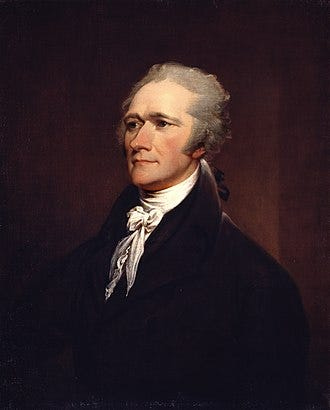
Alexander Hamilton has gained popularity recently, in large part due to the 2015 Broadway musical “Hamilton” by Lin-Manuel Miranda.
What is the real story behind this remarkable revolutionary? What kind of leader was he? How was his background similar and different from the other Founding Fathers?
Birth of Alexander Hamilton
Hamilton was born in Charlestown, Nevis, in the Caribbean, out of wedlock to Rachel Faucette, of British & French Huguenot (French Protestant) descent. She had been married to and had a son with Johann Michael Lavien when she fell in love with the Scottish James Hamilton. She left her husband and their son and moved in with James Hamilton, where she lived with him in Nevis and on St. Croix. Alexander took his natural father’s surname.
Though he owned his paternity of Alexander, his Scottish father had abandoned them when Alexander was around ten when he’d learned her original husband intended to divorce her on the grounds of “adultery and desertion,” hoping to “spare her the charge of bigamy.” His mother ran a small provisions shop operated by the five female slaves she owned. When she died of yellow fever when he was 13, she left him 34 books, and he was mostly self-educated.
Education of Alexander Hamilton
He became an accounting clerk with a local import-export firm and later apprenticed with a merchant. He became good enough as a trader that he ran the firm for five months in 1771. Denied an education in a church school due to his illegitimacy, the young Hamilton had caught the attention of the local Presbyterian minister and occasional doctor, Hugh Knox. The minister noticed his ambition and intelligence and mentored him with a firm intellectual and spiritual grounding, adding classics, literature, and history from his vast library.
With the help of wealthy local citizens, enough money was raised to send him to the mainland, hopefully, to study medicine. Though he passed the entrance exams for Princeton, he decided instead to attend King’s College in New York City, now known as Columbia University.
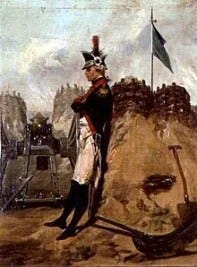
Hamilton became interested in revolutionary politics, meeting other men with similar sympathies and writing anonymously against Loyalist pamphlets. But his education was cut short when British troops occupied the city, and the college closed its doors.
Precocious, vigorously outspoken, and limitlessly ambitious, Hamilton polarized the opinions of his contemporaries. Along with some of his classmates, he joined the New York volunteer militia. He was self-taught in military history and army tactics and was quickly promoted with his company becoming an artillery unit.
Alexander Hamilton and the American Revolution
Hamilton, still in his twenties, was among the inner circle of General George Washington‘s army during the American Revolutionary War and the subsequent early National period. As a lieutenant colonel, he became Washington’s aide-de-camp and was in charge of correspondence with Congress and the writing of orders for the Continental Army.
After four years in the role, he expressed to Washington his intention to return to active combat duty, but Washington was promoting other officers with more field experience and higher rank.
Hamilton eventually sent a letter to Washington, resigning his commission if he did not get a field command. Washington acquiesced and gave him a battalion of light infantry to command.
Hamilton distinguished himself, gaining the glory that he thought would only come with battle, at the Storming of Redoubt #9 and #10, where, along with French support, he took the fortifications at the Battle of Yorktown.
The British General Cornwallis surrendered there, and the war was essentially over. Hamilton retired with the rank of Major General.
Alexander Hamilton: Founding Father?
Ron Chernow’s 2004 biography, Alexander Hamilton, spends a lot of time on his youth and how it impacted his later life. While ambitious and accomplished, Hamilton had not been born into the upper-class planter society like Washington, Jefferson, and Adams. He became friends with John Jay and James Madison, but few others of the Founders.
As we’ve seen, although his parentage was British, French, and Scottish, rumors persisted during his lifetime that he was of mixed blood. Contemporaries like John Adams inaccurately called him a “Creole bastard.”
Alexander Hamilton’s Career and Congress
Hamilton practiced law successfully in New York City. While serving, he called for the funding of the national government by the states and the assumption of state debts by the federal government. He drafted a call to revise the existing Articles of Confederation, the first documents of the U.S. government after the Revolutionary War, which Hamilton considered too weak for current needs.
His writing contained many of the elements that would appear in the U.S. Constitution. These included a strong federal government with the power to collect taxes and fund the army and the separation of powers feature of the Executive, Legislative, and Judicial branches of government.
Alexander Hamilton’s Part in The Federalist Papers
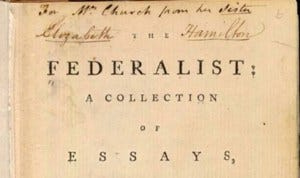
While serving as an assemblyman in the New York State Legislature, he was chosen as a delegate to the Constitutional Convention of 1787. He called the United States “a Hercules in the cradle,” believing in a strong central government and in curbing States’ rights.
While he did not agree with all the elements of the Constitution, he signed it nonetheless and urged others to do the same. He recruited both John Jay and James Madison to write essays to defend the Constitution. These became known as The Federalist Papers; he wrote 51 of the 85 essays.
Alexander Hamilton’s Government Service
As the first Secretary of the Treasury from 1789, he was the principal driving force of Washington’s administration. He created the U.S. central banking system, established the U.S. Mint, and created a System of Cutters, which became the birth of the U.S. Coast Guard.
Affair Scandal of Alexander Hamilton
Hamilton was the first American politician who was involved in a highly publicized sex scandal. In 1791, Maria Reynolds claimed that her husband had abandoned her and appealed to Hamilton for funds to return to her relatives. When he delivered the funds to her, as Hamilton reported,
“Some conversation ensued from which it was quickly apparent that other than pecuniary consolation would be acceptable.”
Their affair lasted for about a year. Her husband began to blackmail Hamilton, and he paid, lest exposure of the affair ruin his public reputation. Nevertheless, in 1797, a journalist exposed the affair, leaving open the suggestion that Hamilton, the Secretary of Treasury, used public funds to pay the the blackmail. Hamilton published a 100-page booklet asserting that he had used his own private funds.
Alexander Hamilton: Abolitionist?
Much has been said of late about Hamilton’s interest in the abolition of slavery in America. Along with John Jay and Aaron Burr, he was among the founders of the New York Manumission Society in 1785, which established the New York African Free School in 1787 for poor and orphaned children of slaves and free people of color.
While the society was instrumental in having a New York state law passed in 1785 prohibiting the sale of slaves imported into the state, it did not accomplish the abolition of slavery. Most other Northern states had already banned the slave trade, with the notable exception of New Jersey. However, it would not be until 1807 that the Federal government would pass such a law. However, this did not stop the practice of slavery.
It would not be until 1799 when John Jay, as Governor of New York State, signed the Act for the Gradual Abolition of Slavery into law. Yet this did not address what civil rights freed slaves might enjoy. There were over 30,000 slaves in New York; they would not enjoy emancipation until July 4, 1827, almost 36 years before the U.S. Emancipation Proclamation.
Alexander Hamilton’s Political Rivalries
Modern Americans may not be able to conceive of a country without political parties. However, President George Washington was able to exercise nonpartisan leadership during the first few years of the new government (begun in 1789) when parties were generally considered factious and hostile to a Republican government.
However, strong division developed over Hamilton’s fiscal program as Secretary of the Treasury, which Washington supported. Hamilton and other proponents of a strong central government formed the Federalist Party in 1791.
As a leader in the Federalist Party, Hamilton opposed the Democratic-Republican candidates, including Thomas Jefferson, for the 1800 election. Hamilton wrote a pamphlet intended only for fellow Federalists called a Letter from Alexander Hamilton, Concerning the Public Conduct and Character of John Adams, Esq. President of the United States. However, it fell into the hands of the Democratic-Republican Party, both destroying Hamilton’s reputation among the Federalists and hurting John Adam’s election campaign, guaranteeing Jefferson’s candidacy.
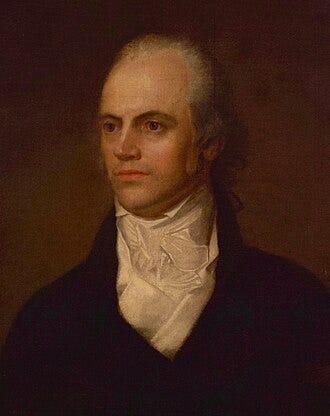
Jefferson ran with Aaron Burr, but they tied for votes. Hamilton had disagreed with Jefferson on many subjects, but he disliked Burr more, calling him a “mischievous enemy,” a “profligate, a voluptuary in the extreme,” and that electing him as President would be tantamount to “signing their own death warrant.” They had been rivals since Burr defeated Hamilton’s father-in-law for a seat in the U.S. Senate, weakening the Federalist Party. Consequently, Hamilton threw his weight behind Jefferson.
The law required that the House of Representatives decide on the issue, naming Jefferson as President and Burr as Vice President. Nevertheless, the rivalry between Hamilton and Burr continued and escalated.
In 1804, a letter was published in the Albany Register opposing Burr’s candidacy for office claiming,
“General Hamilton and Judge Kent have declared in substance that they looked upon Mr. Burr to be a dangerous man, and one who ought not be trusted with the reins of government.”
Burr called for a public denial; Hamilton verbosely denied that he could not be responsible for the letter’s interpretation — though he did not fault it — and eventually, Burr formally challenged him to a duel, which he accepted. Hamilton determined in his own mind beforehand that he would “waste” his shot, not intending to kill Burr. He wrote before the duel a:
Statement on Impending Duel with Aaron Burr in which he stated that he was “strongly opposed to the practice of dueling” for both religious and practical reasons. “I have resolved, if our interview is conducted in the usual manner, and it pleases God to give me the opportunity, to reserve and throw away my first fire, and I have thoughts even of reserving my second fire.”
Death of Alexander Hamilton
Staging the duel, not in New York, but in New Jersey, which was less aggressive in prosecuting illegal duels, they arrived in Weehawken, a well-known dueling location. Indeed, Hamilton’s oldest son, Philip, had previously died in a duel on that site. Hamilton and Burr arrived at 6:30 AM with their seconds. Who fired first is not ascertainable. Hamilton fired intentionally in the air into a tree. Burr’s shot struck Hamilton, mortally wounding him.
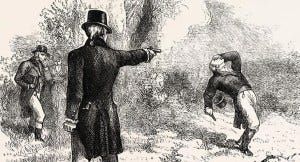
Hamilton was taken to a nearby home and, because he was an Episcopalian at this time, received communion from an Episcopal Bishop. There he was seen by his wife and children.
He was not yet fifty when he died in 1804. He was buried in Manhattan. Though Burr was charged with murder, it never reached trial. Initially, he fled to Georgia, but he returned to Washington, D.C., to finish his term as Vice President. His political career was ended.
Hamilton — The Musical
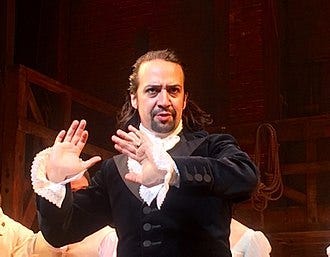
What about the recent Broadway show “Hamilton” currently available on Disney+ TV? How accurate is it historically? I discuss that in my article here.
Bill Petro, your friendly neighborhood historian
billpetro.com
Subscribe to have future articles delivered to your email. If you enjoyed this article, please consider leaving a comment.



